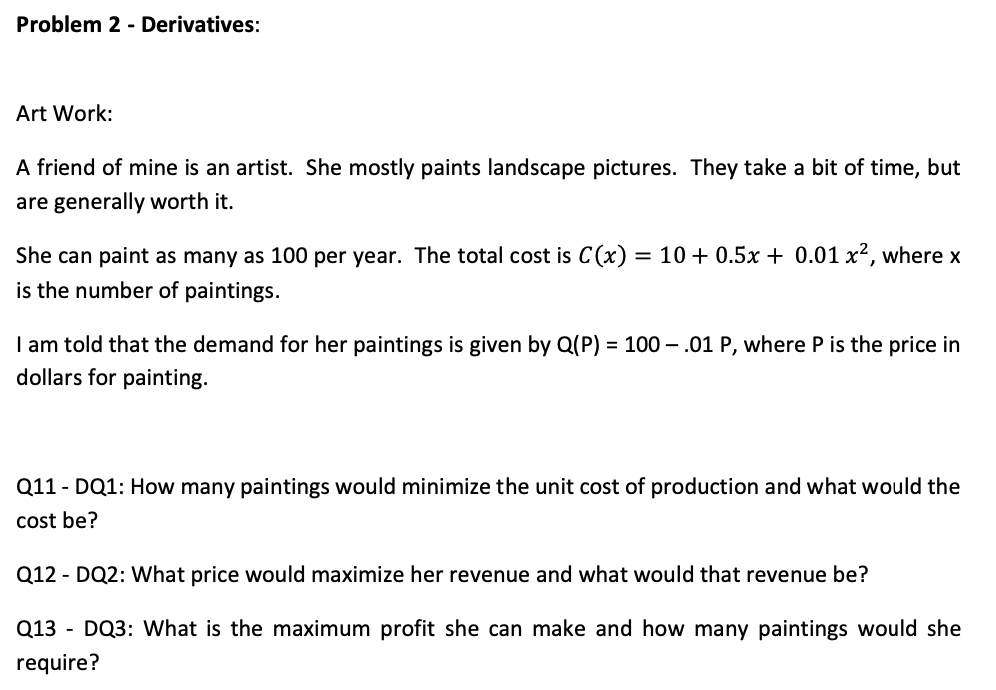Art Work: A friend of mine is an artist. She mostly paints landscape pictures. They take a bit of time, but are generally worth it. = 10+ 0.5x + 0.01 x², where x She can paint as many as 100 per year. The total cost is C(x) is the number of paintings. I am told that the demand for her paintings is given by Q(P) = 100 – .01 P, where P is the price in dollars for painting. Q11 - DQ1: How many paintings would minimize the unit cost of production and what would the cost be? Q12 - DQ2: What price would maximize her revenue and what would that revenue be? Q13 - DQ3: What is the maximum profit she can make and how many paintings would she require?
Art Work: A friend of mine is an artist. She mostly paints landscape pictures. They take a bit of time, but are generally worth it. = 10+ 0.5x + 0.01 x², where x She can paint as many as 100 per year. The total cost is C(x) is the number of paintings. I am told that the demand for her paintings is given by Q(P) = 100 – .01 P, where P is the price in dollars for painting. Q11 - DQ1: How many paintings would minimize the unit cost of production and what would the cost be? Q12 - DQ2: What price would maximize her revenue and what would that revenue be? Q13 - DQ3: What is the maximum profit she can make and how many paintings would she require?
Calculus: Early Transcendentals
8th Edition
ISBN:9781285741550
Author:James Stewart
Publisher:James Stewart
Chapter1: Functions And Models
Section: Chapter Questions
Problem 1RCC: (a) What is a function? What are its domain and range? (b) What is the graph of a function? (c) How...
Related questions
Question

Transcribed Image Text:Problem 2 - Derivatives:
Art Work:
A friend of mine is an artist. She mostly paints landscape pictures. They take a bit of time, but
are generally worth it.
She can paint as many as 100 per year. The total cost is C(x)
= 10 + 0.5x + 0.01 x2, where x
is the number of paintings.
I am told that the demand for her paintings is given by Q(P) = 100 – .01 P, where P is the price in
dollars for painting.
Q11 - DQ1: How many paintings would minimize the unit cost of production and what would the
cost be?
Q12 - DQ2: What price would maximize her revenue and what would that revenue be?
Q13 - DQ3: What is the maximum profit she can make and how many paintings would she
require?
Expert Solution
This question has been solved!
Explore an expertly crafted, step-by-step solution for a thorough understanding of key concepts.
Step by step
Solved in 4 steps

Recommended textbooks for you

Calculus: Early Transcendentals
Calculus
ISBN:
9781285741550
Author:
James Stewart
Publisher:
Cengage Learning

Thomas' Calculus (14th Edition)
Calculus
ISBN:
9780134438986
Author:
Joel R. Hass, Christopher E. Heil, Maurice D. Weir
Publisher:
PEARSON

Calculus: Early Transcendentals (3rd Edition)
Calculus
ISBN:
9780134763644
Author:
William L. Briggs, Lyle Cochran, Bernard Gillett, Eric Schulz
Publisher:
PEARSON

Calculus: Early Transcendentals
Calculus
ISBN:
9781285741550
Author:
James Stewart
Publisher:
Cengage Learning

Thomas' Calculus (14th Edition)
Calculus
ISBN:
9780134438986
Author:
Joel R. Hass, Christopher E. Heil, Maurice D. Weir
Publisher:
PEARSON

Calculus: Early Transcendentals (3rd Edition)
Calculus
ISBN:
9780134763644
Author:
William L. Briggs, Lyle Cochran, Bernard Gillett, Eric Schulz
Publisher:
PEARSON

Calculus: Early Transcendentals
Calculus
ISBN:
9781319050740
Author:
Jon Rogawski, Colin Adams, Robert Franzosa
Publisher:
W. H. Freeman


Calculus: Early Transcendental Functions
Calculus
ISBN:
9781337552516
Author:
Ron Larson, Bruce H. Edwards
Publisher:
Cengage Learning